Summary (red font):
We need a sober and realistic re-evaluation as to what Stonehenge represented. I say it existed for two-stage disembodiment of the recently dead – first by scavenger birds (“sky burial”) closely followed then – and only then – by fire. What it did, it did efficiently, which is why it continued to grow and develop over the course of many centuries, as more and more level perch-space was installed with each new addition of megalithic lintels – first from those 5 separate trilithons, colour coded yellow in my new banner, then with that even more spectacular outer stone circle, colour coded pink. Stonehenge was fit-for-purpose. The fact that for many modern-day minds that purpose is/was unspeakable is neither here nor there. Stonehenge was not designed for modern 21st century users of the internet, a phone call away from modern undertakers should their services be suddenly required. It was designed for Neolithic man with no telephone, no internet, no metal spades (mere antler picks), no tarpaulins and thus no reliably dry source of firewood. Stonehenge was a product of its times – correction- a very advanced, sophisticated way-ahead-of-its-times product of human resourcefulness and ingenuity…
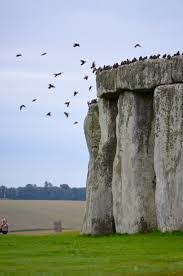
Those megalithic sarsen lintels make a most attractive perch, safe from ground-based predators… Might they have once been attractive for an additional reason?
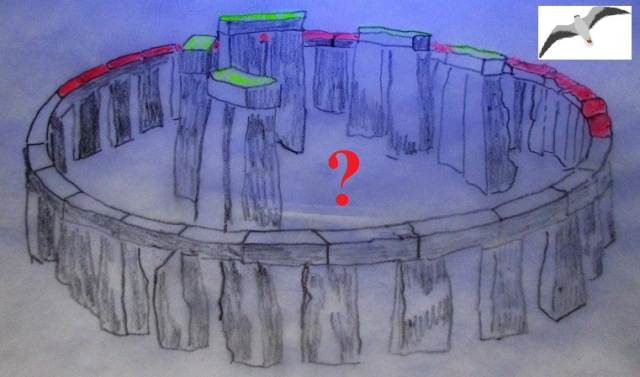
Can you guess why I’ve now shown the monument as it probably looked circa 2500BC, AND why I’ve colour-coded just the tops of the lintels (yellow for each of the 5 trilithons, pink for part of the outer stone circle) AND added a token seagull? What might have attracted voracious gulls to Neolithic Stonehenge? Clue: think modern-day landfill sites…

Here’s another clue (that modern-day landfill site mentioned earlier, attracting not just scores, but HUNDREDS of gulls …)
Question: In the context of this iconoclast’s AFS thesis (AFS = avian-facilitated skeletonization), considered a necessary preliminary to fuel-efficient cremation, what was the separate (?) role of the higher trilithon and circular top surfaces?
Was the smaller but higher trilithon surface (colour-coded yellow) intended primarily for assembled birds, with the much greater lower circular surface, colour-coded pink, for pecking away at the bodies of the recently deceased OR was it vice versa? Or were both perching areas, with the deceased placed at or near ground -level in the centre of the site?
More to follow…
Tue March 13
Am presently assembling a list of collateral evidence that supports my thesis that Stonehenge was first and foremost designed as a pre-crematorium, dependent on AFS for initial de-fleshing, then followed by final fuel-efficient cremation and bone disposal.
There are some 20 items in my list so far, which I’ll post here in due course.
Update: March 20: Now have some 30 points listed! Have so far encountered some scepticism and nitpicking on a couple of other websites, but thus far no serious arguments against the ‘bird perch’ interpretation, merely incredulity that Neolithic man would go to such time and trouble to construct a megalithic bird perch! To which I would say: put yourself in the position of Neolithic man, with no proper coffins, no metal digging implements with which to dig deep graves, lack of a year-round supply of dry firewood in sufficient quantity for efficient and complete whole-body cremation etc. Solution: prior AFS (avian-facilitated skeletonization, aka ‘sky burial’) followed by fuel-efficient cremation of what remains. Relatives then given an inoffensive compact package of ash to save or dispose of as they wished.
Have the advocates of intentional solstice-alignment ever undertaken a similar exercise? Not to my knowledge they haven’t. That straightaway betrays an entirely non-scientific (arguably unscientific) approach, especially when it involves promotion of an almost certainly dud and indeed decrepit model (made even less excusable by constant bad-mouthing of anyone who dares to challenge the status quo).
Actually, I may hold off publishing those 20+ reasons, accumulated over 6 years, that support my AFS model. I’m now realizing the futility of using the blogosphere as a means of inserting new thinking into the public domain.
So-called search engines, Google especially, must take a major share of the blame. Despite going for 6 years, this site is nowhere to be seen on a simple search under (stonehenge). It then becomes a Catch-22 situation – no visibility on a simple search means no adventitious site visitors worth speaking of. Visits to other so-called Stonehenge blogsites are generally a waste of time, as I’ve discovered over and over again, given the cool or frigid reception and/or rejection there (generally) to new ideas (invariably dubbed “hang-ups”, “obsessions”, “fixations” etc etc).
Maybe it’s time to consider an approach to the good old-fashioned mass media, e.g. popular dead-tree science press.
Progress report (involvement of MSM), March 15
It’s now some 24 hours since I sent the following email to the features commissioning editor of a high-profile MSM periodical:
| Subject: A totally new and original angle on Stonehenge, product of a 6 year gestation period… | |
| From: | sciencebod@xxxxxxxx |
| To: xxxxxxx xxxx | |
| Date: | Wed, 14 Mar 2018 10:54 |
| Attachment the second image on this posting – that colour-coded artist’s impression of Stonehenge – link opposite). | galleryswstonehenge1…jpg (561 KB) |
Hello xxxxxxx
#####
So far, no response, not even an auto-acknowledgement, despite offering first refusal! How long should one wait before trying somewhere else?
…
Those of you who have followed the comments posted to this site recently, and the exchanges I’v had on two other sites ( Tim Daw’s sarsen.org and Brian John’s Stonehenge/Ice Age sites) may not be surprised to read what I’m now about to say.
My views have hardened. Suggestions that my “bird perch” interpretation of Stonehenge are ill-considered, off-the-wall etc are firmly rejected. I first proposed the bird perch idea as long ago as April 2016 on my sciencebuzz site, and was flirting with different excarnation models some two years before that, based on curious details regarding the winter-feasting at Durrington Walls, on the mysterious ‘organic’ packages interred into Silbury Hill, on the BBC’s 1999 article on Seahenge, on proposed excarnation sites in the Golan Heights, in Anatolia (Gobekli Tepe) etc etc. The idea of a sudden brainstorm is simply not supported by the record of my postings over 6 years that are a diary of how a retired PhD scientist, one who has trained and examined other PhD scientists, operates when left to his own devices, deploying the internet/bloosphere thus far as sole medium of communication.
As I say, my views have hardened. The bird-perch paradigm should cease being dismissed out of hand, or considered a poor relation to the fanciful unsupported ‘solstice’ dogma (that being the sudden 18th brainwave from William Stukely that its present day exponents cannot be bothered to properly assess and document and merely wax eloquent and promulgate).
Let me say this once, and once only. It is my bird perch model that should now be seen as the DEFAULT MODEL. The image above of the colour-coded artist’s impression should be widely circulated. Those who don’t care for it should get busy and seek out compelling evidence for dismissing it. I in the meantime will try to add to my list of 20 supporting points, but I have to say I’m not optimistic. There’s only so much one can do 4,500 years after fashions in disposal of the dead changed (probably as a consequence of Bronze Age Beaker folk originally from Ukraine and Kazakhstan displacing earlier Neolithic settlers from Anatolia).
There’s the old saying that if it looks like a duck, walks like a duck, then it probably is a duck.
If it looks like it served as a bird perch 4,500 years ago, and STILL SERVES AS A BIRD PERCH to this very day, then IT ALMOST CERTAINLY WAS INTENDED AS A BIRD PERCH.
############
Still Thur March 15, now 21:30
Still no reply from that MSM periodical. If I don’t hear from them by tomorrow, Friday 5pm, I shall try somewhere else (while at the same time dispensing with plans to open a regular £4.50 per week subscription with my newsagent). There’s simply no excuse for bad manners – any place, any time – least of all in the world of ideas.
Fri March 16
I sent my proposition to that MSM periodical last Wednesday with no great hopes of a response (having done the same some years ago with my thinking re the Shroud of Turin, and getting no response, no acknowledgement whatsoever!).
Surprise, surprise. 2nd time around: still no response!
I’ve been looking at the periodical since my teens – some half a century ago – and ever so gradually come to the conclusion that it does no favours whatsoever to Science UK. It simply feeds off the output of science – national and international – purely to siphon off a pop journalistic profit for itself (though things must now be getting tough, given it now charges £4.50 weekly at the newsagents for a slim offering that is oh-so- ho-hum for the most part).
Here are two images that sum up my opinion of the periodical in question, given the school-masterly blurb it gives online to would-be contributors, telling them at length what they must and must not do if wishing to be considered for publication:
Image 1: preliminary treatment with scissors of their current yawn-provoking offering:
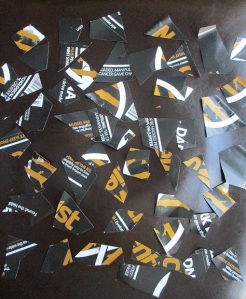
Image 2: where the above has now been consigned in this science blogger’s household:
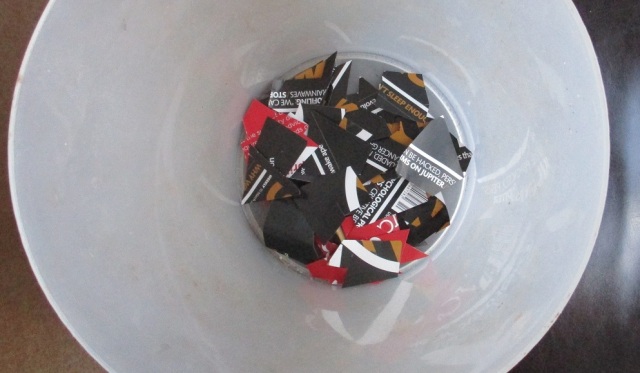
Goodbye, good riddance – you bunch of opportunist parasites…
………………..
Have decided to add the image* that appears second on this post to the end of ALLmy Stonehenge postings (some 24 in all, here and on my sciencebuzz site) as an addendum to ALL postings. Why not – since it’s my considered answer to the ‘mystery’ of the monument’s peculiar architecture, the conclusion to some 6 years of deliberation?
I say Stonehenge was designed as a giant bird perch, a ceremonial monument dedicated to ‘sky burial’, i.e. soul release from mortal remains to the heavens via AFS (avian-facilitated skeletonization, considered the height of fashion (and practicality) in Neolithic-era 2500BC! The stripped remains were then cremated, so an apt description of Stonehenge might, as previously suggested, be PRE-CREMATORIUM.
March 18 2018
Well, I have have assembled in first draft form that complete list of my 25 postings on Stonehenge and related topics, starting Spring 2012, with “birds” making their first tentative appearance in the keyword labels in 2016, But there’s still editing, highlighting etc to be done, which is best done in WordPress Compose mode, i.e online. Rather than construct as an entirely new posting with attendant risks of losing en route to completion (don’t ask!), I shall build it on the end of this posting first, as a series of instalments. Once complete and I’m happy with the way it looks I may then cut and paste (or copy and paste) to the site’s next posting.
Purpose of the exercise? To shoot down that absurd suggestion that my “bird perch” model is over-hasty and ill-considered! It’s been 6 years in the making, preceded by two earlier excarnation models, the first for nearby Durrington Walls, down by the river, the second for Silbury Hill – part of this site’s title, some 20 miles away. That’s not counting the early mention of the BBC’s 1999 feature on what was dubbed ‘Seahenge’, up on the Norfolk coast, with its specific and candid reference to excarnation as its prime purpose! (The BBC later dropped references to excarnation in connection with Seahenge, probably for all the wrong reasons, i.e. fearful lest it be a taboo topic, certainly not for those of a nervous disposition, i.e. 99% of entire UK viewing public!)
You just can’t get the commentators these days – given to making their own over-hasty and ill-considered judgments. It’s especially galling when they try to teach their grandmother, or in this case -father, to ‘suck eggs’ (like delivering impromptu mini-lectures on the scientific method to someone who’s spent his entire career in scientific teaching and research!).
Expect to see that list of 25 postings and labels take shape below in the next day or two. I shall say no more for now about what prompted the exercise, unless provoked further from the same know-all, “I’ve written-a-book-on-Stonehenge-didn’t-ya-know?” individual.
I haven’t written a book on Stonehenge or on my other interests, and have no intention of doing so (though I used to contribute chapters to scientific treatises). The trouble with writing books, at least on longstanding “mysteries”, “enigmas” etc is that they invariably require one to crystallize thoughts too soon, i.e. prematurely. They also require one to constantly promote one’s book, or risk it slipping from sight… In contrast, I personally use the internet to report a scientific learning curve, warts ‘n’ all, and when there’s new or revised new thinking use a blogsite as an archival diary to update the old via NEW postings. (What a shame, nay scandal, that Google rankings do not recognize this opinion-forming non-commercial, non-profit-making use the internet!). Yup, one has to feel sorry for those perilously-close-to-their-sell-by-date authors, having constantly to visit others’ websites to promote their past offering, feeling obliged to slip in those little references to their Amazon listings …
Here’s that list (in instalments)
1. Why is Salisbury Plain so steppe-like? A prelude to another look at the Stonehenge mystery
SBuzz: 10/05/2012
Labels: Brian John, Google Earth, MOD, mystery, oasis, prelude, Salisbury Plain, steppe,
###########################
SBuzz: 17/05/2012
Labels: captive earthworms, chalk, communal reliquary, David Field, evisceration, heart, Jim Leary, Neolithic, new theory, organic mound, prehistoric Britain, sciencebod, silbury hill, souls, Stonehenge, vital organs
###########################
SBuzz: 19/05/2012
Labels: bluestones, cannibalism, Durrington Walls, flints, Neolithic, new theory, pigs, recycling centre, Salisbury Plain, sciencebod, secondary necrophagy, silbury hill, Stonehenge, Stonehenge theory, winter, Woodhenge
###########################
4. Why was Stonehenge constructed with those woodwork joints (mortise and tenon; tongue in groove)?
Suss: 02/06/2012
Labels: enemy, joints, lintels, mortise and tenon, sarsens, sciencebod, stone circle, Stonehenge, sussing out stonehenge, theory, tongue in groove, woodwork
###########################
SBuzz: 06/06/2012
Labels: dark side, Durrington Walls, light side, Neolithic, silbury hill, survival, winter diet
###########################
SBuzz : 08/06/2012
Labels: burial, captive earthworms, compost heaps, Durrington Walls, excarnation, heart, internal organs, Neolithic, pigs, pork, scavenging, secondary cannibalism, silbury hill, soul, Stonehenge, theory, winter survival, Woodhenge
###########################
7. Neolithic Silbury Hill: communal earthworm-implanted compost heap for freeing trapped souls from mortal remains?
SBuzz: 09/04/2016
Labels: ancient-origins website, biodegradation, compost, earthworms, local soil, Marlborough Mound, necropolis, Neolithic, new theory, organic mound, sarsen stones, silbury hill, subsoil, turf
###########################
8: Genesis of a new theory for Neolithic Silbury Hill – a gradual merging of multiple, soul-releasing compost heaps.
Suss: 11/04/2016
Labels: compost heaps, deceased, earthworms, gravel, Leary and Field, mortal remains, mud, organic mound, topsoil, vital organs
###########################
Suss: 12/04/2016
Labels: animal scavengers, bones, consolation prize, David Field, Jim Leary, Neolithic, ribs, rounded, sarsen stones, silbury hill, soft tissue interment, sticks
###########################
10: Might the standing stones of Stonehenge and Avebury have been purpose-built for ‘sky burial’, providing a secure perch for crows or maybe seagulls to roost or nest?
Suss 17/04/2016
Labels: Avebury stone circle, bones, cardionecropolis, carrion crows, defleshing, excarnation, Neolithic Britain, new theory for stonehenge, passive excarnation, roosting birds, seagulls, silbury hill, skeleton, sky burial, Stonehenge, West Kennet Long Barrow
###########################
10 down, 15 to go. (No 10 was the landmark posting, as flagged up previously – first reference to “birds” etc in the keyword labels, but NOT the first to excarnation by other means, i.e. those “birds” were merely the development of an ongoing theme, part of a logical progression, NOT as claimed (by one or more internet-detractors) a sudden bolt from the blue).
###########################
SBuzz: 18/04/2016
Labels: Avebury, bird perches, bluestone, ease of cleaning, excarnation, igneous rock, porosity test, Preseli, sandstone, sarsen, sky burial, spotted dolerite, standing stones, Stonehenge
###########################
12. Here’s how I think Stonehenge was constructed, and why it needed those carpentry joints…
Suss: 21/04/2016
Labels: carpentry joints, engineering aid, lintels, mortise and tenon joints, round peg in round hole, temporary aid to stability, tongue-and-groove joints
###########################
13. Stonehenge can be thought of as a Flintstone-era funeral parlour. Its sales pitch was soul-releasing sky burial AND, by way of bonus, a compact take-away package of cremated bones.
S Buzz: 25/04/2016
Labels: bird figurines, bird sanctuary, bone and skeleton recovery, bone cremation, excarnation, House of the Dead, mortuary house, stone circles, Stonehenge, Vincent Gaffney, Wiltshire, Woodhenge
###########################
14. Might Stonehenge have been designed as an easily-spottable feeding station for high-flying seagulls – as perhaps was the nearby “Cursus”?
SBuzz 27/04/2016
Labels: bank, bird’s eye view, chalk, Cursus, defleshing, ditch, excarnation, landmark, new theory, scavenger birds, stone circle, Stonehenge, timber posts
###########################
15.How Britain came to possess Stonehenge, Avebury stone circle, Silbury Hill etc – in just 350 words.
S Buzz: 30/04/2016 –
Labels: artificial cliffs, burial, chalk, cremation, dolmens, excarnation, gulls, henges, Korea, lintels bird perches, new theory, scavenger birds, seagulls, silbury hill, sky burial, Stonehenge, timber posts
###########################
16. The true purpose of Stonehenge was avian-facilitated skeletonization, aka “sky burial” (which we don’t hear from either English Heritage or the UK’s squeamish media).
SBuzz: 04/05/2016
Labels: Avebury, avian-facilitated skeletonization, Chris Collyer, crows, defleshing, English Heritage, excarnation, gulls, Neolithic Britain, scavenger birds, skeletonizing the dead, sky burial, Stonehenge
###########################
17. Thanks Energyman: the lintels of Stonehenge would indeed have protected sky burial birds from ground-based predators.
SBuzz: 07/05/2016
Labels: bank, bird’s eye view, chalk, Cursus, defleshing, ditch, excarnation, landmark, new theory, scavenger birds, stone circle, Stonehenge, timber posts
###########################
18. Shhhh. Stonehenge was simply a megalithic BIRD PERCH for SKY BURIAL of the dead.
SBuzz: 17/05/2016
Labels: AFS, alignment, avian-facilitated skeletonization, dawn, English Heritage, excarnation, Judith Dobie, pre-crematorium, scavenger birds, Seahenge, Stonehenge, summer solstice, sunrise, temple
###########################
19. It’s time to get real about Stonehenge – Britain’s premier ‘SKY BURIAL’ site
SBuzz: 23/05/2016
Labels: AFS, Arbor Low, Carnac, excarnation, Gobekli Tepe, Ring of Brodgar, Rollright Stones, Rujm el-Hiri, Seahenge, Avebury, sky burial, Stonehenge, template for ideal sky burial site
###########################
Suss: 19/02/2018
Labels: avian-facilitated skeletonization, birds, disposal of dead, excarnation, giant bird perch, Heel Stone, Neil Wiseman, pre-crematorium, prevailing south-westerly winds, protection, sarsen.org, sciencebod, sky burial, Timothy Daws, windbreak
###########################
20 down – just 5 more to go (phew!)
###########################
Labels: Aubrey holes, chalk embankment, new ideas, open fires, pre-crematorium, prevailing south-westerly winds, scavenging birds, sky burial, Stonehenge, windbreak
###########################
22. New or neglected evidence for Stonehenge having existed primarily as a site for ‘sky burial’ (well-supplied with bird perches!).
Suss: 07/03/2018
Labels: avian-facilitated skeletonization, de-fleshing, excarnation, lintels, new thinking, pre-crematorium, seagulls, sky burial, stonehenge new theory
###########################
23. Comment promoted – from Neil Wiseman (author of ‘Stonehenge and the Neolithic Cosmos’)
Suss: 10/03/2018
Labels: Neil Wiseman
###########################
Suss: 12/03/2018
Labels: AFS, bird perches, bird’s eye view, excarnation, forget those solstices, lintels, preliminary to cremation, real purpose, seagulls, sky burial, Stonehenge, trilithons, unfashionable theory
###########################
SBuzz: 13/03/2018
Labels: AFS, bird’s eye view, de-fleshing, excarnation, giant bird perch, megaliths, new theory, pre-crematorium, sarsen stones, seagulls, Stonehenge
###########################
In passing: have just spotted this recent entry in Google listings:
Building Stonehenge was about ceremony and celebration, experts …
9 Mar 2018 – The act of building Stonehenge may have been as important a ceremony to its ancient creators as the use of the finished stone circle, experts have said. Following the discovery of feasting at the nearby Durrington Walls settlement, which attracted people from across the country to help build the neolithic monument, English …
“Ceremony and celebration” ? Not just the end-product the construction site as well! Evidence?
Ah, those “experts” (English Heritage). They would say that, wouldn’t they?
Still March 18
I shall now copy-and-paste it to Comments!
March 19, 2018
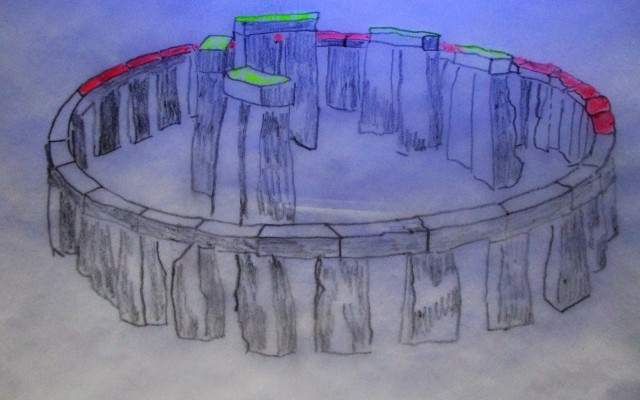
So how many reasons can the summer or winter solstice (or lunar cycle) promulgators of English Heritage and elsewhere muster I wonder?
March 20, 2018
Have been fine-tuning the new banner on this site. While a few more tweaks may be needed, here’s how it looks at present:

Thought I’d add a hint as to where my Silbury Hill ideas have appeared elsewhere, with its original ‘earthworm’ proposal (if only to disabuse a recent commentator of his quaint belief that I’m invisible on the wider internet). Not so, dear fellow: maybe it’s you who should get down off that high horse of yours and start “reading more widely”).
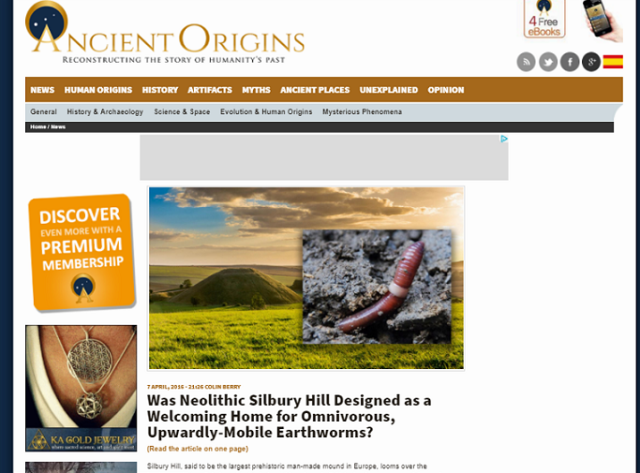
My article in ancient-origins.net, April 2016. See link below.
March 22 2018
Have decided against starting that new posting just yet (the one flagged up earlier with those 30+ supporting pieces of evidence in favour of Stonehenge having been created as a mega-bird perch for pre-cremational excarnation)
However, I can’t have folk, the knocking brigade especially, thinking that list is make-believe. Here it is thus far in telegraphic form. It may be some days, possibly weeks before I take each point in turn, and attempt to build a convincing argument for each.
1. Neolithic predicament re efficient body disposal.
2.Need to preface cremation with excarnation.
3.Outsourcing of excarnation/cremation to specialist sky burial/cremation site and professionals.
4.Reason why animal bones accompany human ones (Neolithic barter economy).
5.Evidence from Guernsey archaeology for cremation of excarnated bones as distinct from whole cadaver.
6.Numerous other sites, in Britain, continental Europe, from Asia Minor to Far East etc show evidence of monumental constructions that are seemingly custom-made to attract excarnating bird life.
7.Important parallels between ‘Seahenge’ on the Norfolk coast and Stonehenge. BBC (1999) report alludes to excarnation.
8. Explanation for Stonehenge’s ‘salt-tolerant lichens’ – suggesting seagull presence.
9.Explanation for lintels as additional perch capacity, needed when relying on seagulls etc as distinct from Continental and Eurasian vultures.
10.Rationale in ‘bird perch’ terms for adding bridging lintels to span uprights.
11. “House of Dead” near Stonehenge can hardly have been a house – with its forest of ‘indoor’ timber posts Same applies to another so-called house, or at any rate allegedly roofed structure at ‘Woodhenge’.
12.Rationale for non-defensive chalk embankments, aka henges in terms of sky burial. Gypsum coating on middle of 3 Thornborough Henges to render more visible from afar (to birds, not people!).
13.Rationale for dual-purpose “Aubrey holes”, initially as supports for timber poles or bluestone pillars. later as graves.
14.Two alternative non- archaeoastronomical explanations, for alignment of Stonehenge and other henge/pseudo-henge sites with one of more access points in a raised embankment.
15.The curiously un-remarked upon beaked arguably bird-like characteristics of the so-called sarsen “Heel Stone” (an unhelpful and potentially misleading description) that may have influenced choice of Stonehenge’s location.
16.Stonehenge as a site for fulfilling a range of funeral requirements simultaneously on a reasonable timescale geared to needs of the bereaved who may have travelled some distance.
17.Need to integrate the presence of accumulated cremated bones into a single overarching narrative.
18.New interpretation of use made of imported lithophonic Preseli bluestones (“dinner bell”).
19.Lack of incised insciptions on megaliths to support non-excarnation narratives. But Bronze Age daggers and axe heads.
20.Rationale for co-existence of animal bones among cremated remains – supplementary offerings to encourage bird life to stay in vicinity.
21.Significance of profusion of barrows etc on Salisbury Plain.
22.Paucity of evidence for link to solstices etc.
23.Multiple expressions of the Neolithic perceived need for prior excarnation.
24.Integration with Avebury, Silbury Hill etc, albeit some 20 miles away.
25.Integrating somewhat disturbing features of Durrington ‘winter feasting’ into excarnation narrative.
26.Explanation for the laboriously fashioned but out-of-sight woodworking joints.
27.Integrating the Cursus forerunner.
28.Attraction of Stonehenge for modern birdlife.
29.Search for Stonehenge counterpart equivalent to Seahenge’s central altar-like upturned tree stump.
30.Ancillary clues to ‘sky burial’ having been practiced in and around Stonehenge.
31.Rationalizing the presence of timber posts, later on stone pillars at numerous Neolithic sites, usually within a banked enclosure, for sky burial purposes.
32.New interpretation of dolmens as small-scale versions of Stonehenge.
33. Need for long-overdue break with conferring a slit personality on Stonehenge (sun-worship/place of the dead). Dispense finally with the first of those two. De-fantasize, de-romanticize.
34?
We need a sober and realistic re-evaluation as to what Stonehenge represented. I say it existed for two-stage disembodiment of the recently dead – first by scavenger birds (“sky burial”) closely followed then – and only then – by fire. What it did, it did efficiently, which is why it continued to grow and develop over the course of many centuries, as more and more level perch-space was installed with each new addition of megalithic lintels – first from those 5 separate trilithons, colour coded yellow in my new banner, then with that even more spectacular outer stone circle, colour coded pink. Stonehenge was fit-for-purpose. The fact that for many modern-day minds that purpose is/was unspeakable is neither here nor there. Stonehenge was not designed for modern 21st century users of the internet, a phone call away from modern undertakers should their services be suddenly required. It was designed for Neolithic man with no telephone, no internet, no metal spades (mere antler picks), no tarpaulins and thus no reliably dry source of firewood. Stonehenge was a product of its times – correction- a very advanced, sophisticated way-ahead-of-its-times product of human resourcefulness and ingenuity…
Late insertion (March 23) : I posted the above summary yesterday in standard black font, but later decided to send it to a contact in the MSM (one who previously approached me for advice on another matter, unrelated to my main interests) on the off chance his outlet might be interested. Given the length of this posting I’ve now decided to copy it a second time, using it as a Introduction/Summary for this present posting (and indeed my entire 6 years research into the real use made of Stonhen
Moving on: does anyone know where I can locate images showing the upper sky-facing surfaces of the lintels in close up? So far no luck with that search, but there are grounds for thinking the evidence I seek to test a prediction may be there (see image below).
Prediction? If as I propose the lintels were intended as bird perches, then provision might have been made for a supply of drinking water as well? Clay dishes? Maybe, but there would have been a risk of them getting blown or knocked over! Solution: create hollows in the tops of lintels, maybe adding to existing ones, crevices etc that would trap rain water, and/or which could have been re-filled manually at intervals.
Here’s that promising looking image:
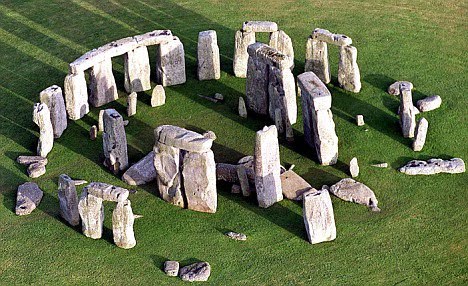
From: https://blog.stonehenge-stone-circle.co.uk/page/95/?5743a200
Are there not indeed many hollows and crevices in the tops of the lintels such as I have predicted, maybe too many for all of them to be explained away as merely natural features of no practical significance? I’m assuming they are not simply surface encrustations of lichen. Thus the need for some close-up pictures…
March 23 2018
Silly me. I temporarily forgot that the splendid stonesofstonehenge site not only has images of all the separate stones with their systematic numbering system. There are multiple images of each stone including the sarsen lintels (numbered with 1, followed by 2 more digits) and most if not all those lintel galleries have a view of the upper surface included! Today I shall try to find time to go through them all and pull out the best pictures (i.e. those that display the most convincing of my predicted ‘bird baths’ that is, whether formed naturally or laboriously carved by Neolithic handtools into the sandstone!)
March 28 2018
This site was given a new title yesterday. Before it was “Sussing out Stonehenge – and Silbury Hill too”.
It’s now (after some 6 years deliberation) a lot more emphatic in its message: ”
How best to summarise the role of Stonehenge in Neolithic and early Bronze Age Britain? Answer: how about?
Putting sky burial on a pedestal. Correction: twin or multiple pedestals!
Thinks: once Google gets around to listing this site under a simple “Stonehenge” search, I might think of throwing a street party.
Nope, on second thoughts, maybe a geographically-more-appropriate party, say on The Avenue approach to the monument. (Thank goodness it’s not excessively wide – multiple rustic trestle-bench hire for outdoor party-goers can work out quite expensive these days. Well-spaced benches along the length within megaphone hearing might be more economically feasible to this fixed-income pensioner).
Naturally I’d need to scatter the length and breadth of The Avenue a few days ahead of time with avian nutrition (modern-day vegetarian I hasten to add!) for truly authentic (?) Neolithic atmosphere, say with Poundland’s wild-bird seed (ouch, now £2 a bag – definitely worth a reference to my local Trading Standards!).
Apols to my US readers for all the parochial references…
Thursday March 29:
Speaking of our Stateside friends: here’s a message that might appeal to those across the pond.
Do any of you have contacts in the media (at State or national level) who might be interested in the giant bird perch/pre-crematorium message now being promulgated on this site (currently receiving the customary treatment that the UK press accords unconventional new thinking that does not come from their regular soundbite suppliers!).
Single out (via comments) a named MSM site that you intend to contact, succeed in getting it to publish this site’s message, minimum 250 words, such that it puts this site into Google’s (stonehenge) top 100 rankings (Past Week, Past Month filters initially) and a $100 Amazon voucher will come winging your way! Or Canadian currency equivalent!
Saturday March 31st, 2018
Things are really looking up on my Shroud of Turin site where clicks and visitors are concerned (but then it is Easter!)

And it’s just late afternoon, with more than 7 hours to go to midnight!
Wish I could say the same for visits to this site. But when one is told, as was the case some 2 years ago, that the hypothesis unveiled was surely “tongue in cheek”, then it’s hardly surprising that one’s not getting the hits.
My views on the Shroud of Turin were similarly described as “surely tongue in cheek?” some 5 or 6 years ago. Those folk are not saying that now, and indeed have gone strangely silent. Why? Because my Shroud views are now backed up by intensive research, reported through some 350 online postings, with new original findings …
How much longer before the world realizes the potency of the scientific method, starting from afresh with a blank sheet, and putting all the existing cosy, conventional thinking to one side?
Stonehenge was created in instalments, spread over centuries, as a giant bird perch. Period. It was designed for pre-cremational processing of the dead, to avoid the horrors of attempting to cremate whole bodies with inadequate resources (i.e. less-than-abundant supplies dry firewood etc). Period.
Come on world. Get real. Catch up with historical reality…
Sunday April 1st 2018
So how come alternative narratives to the long-established ones are not allowed a look-in where either the Shroud of Turin or Stonehenge are concerned, at least where UK media outlets are concerned?
Leaving aside the indifference or frank antipathy displayed by liberal arts- disposed media types towards the boring old longwinded hand-waving scientific community, there has to be a reason, but what?
I think I know. The Shroud of Turin is seen as eye candy for a sizeable segment of the Catholic community, to wit, those who gain comfort from imagery (relics etc), deployable at least once a year (right now in fact).
Stonehenge? For “Catholic”, substitute pre-Christian, pagan, Druid, sun or moon worshipper etc etc , deployable on either the shortest day of the year (winter solstice), the longest day of the year (summer solstice) and even I see on the recent vernal equinox (March 20), though don’t ask me why.
We’ve all heard of the ‘silly season’, i.e. during the main holiday period, July/August, when the media dredge up the old favourites (UFOs, conspiracy theories, jackdaws that can count from 1 to 7 etc etc) and dust them off for yet another annual showing. Think of the Shroud of Turin and Stonehenge in much the same light – standbys for those who are happier cranking the same old handle, fearful of new thinking, new ideas… Best to stick with what’s comforting and familiar. Five minutes going through yellowed press cuttings is all that’s necessary. Do a Google search under a Past Year filter? Good heavens no! That’s for computer nerds only!
April 15, 2018
It sometimes takes a little time for one’s myth-busting claims not just to be accepted, but to become the new norm. Such is the case with my 32-year old paper on ‘enzyme-resistant starch’ (“RS”, aka RS3, man-made dietary fibre!). It didn’t just claim that RS in baked goods (bread, biscuits etc) comprised short-chain fragments of crystallized starch. It gave virtually unequivocal proof that RS was NOT the familiar retrograded long-chain amylose starch as pretty well everyone else at the time presumed (bar the editors of the Journal of Cereal Science) ! It was a new crystalline SHORT CHAIN species!
That 1986 paper was referred to last year as “highly influential”, with 5 excerpts being quoted.
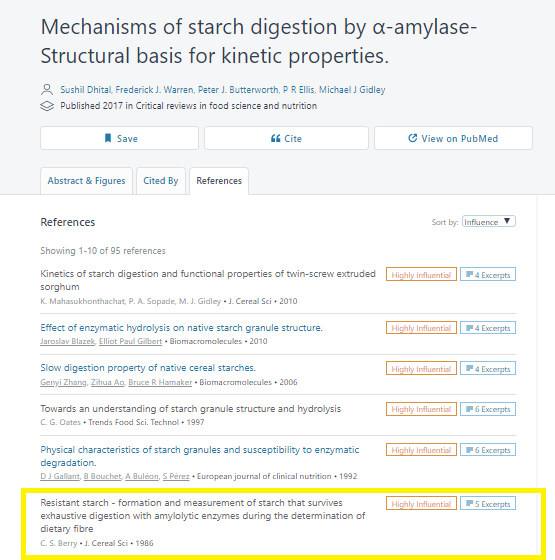
Back in 1986 I was being peed upon by all and sundry from a great height, including a ‘Professor Big’ in starch chemistry as a Kelloggs Symposium!
Sunday 22nd April, 2018
Barriers to uptake of new scientific ideas
1. That Google so-called ‘search engine’ – artificial ventilator for e-commerce more like it, with Google taking a fat percentage. Lousy deal for blogs – failure to flag up headlines of new postings etc. Vicious circles re ranking – high ranking ensures more clicks – deserved or otherwise. Low ranking denies searchers under simple search term entries (“Shroud of Turin”, Stonehenge” etc knowledge of new ideas. Google is anti-idea, pro commission-generating click-bait. Google and its ilk, mostly California-based, is putting the Enlightenment into reverse.
2. Social media – year-on-year dumbing down …
3. Antipathy of mass media towards science and scientists – unless conforming to stereotypes …
4. Vested interests pushing conventional views that serve own interests – ideological, commercial etc…
5. Inertia – old ideas get rooted. New ideas instantly ridiculed. (Read James Watson’s stupendous ‘Double Helix’: see how genetic material was presumed for decades to be protein on scarcely any real evidence, merely a ridiculing of DNA with just 4 constituent bases (A,T,C,G) . Chargaff’s rules (purine = pyrimidines, A=T, C=G etc) dismissed). Old hands, old ideas loath to give up on their ‘expertise’, alleged not-to-be-questioned grasp of detail etc.
6. Failure of commenters on web forums to make URL links to unconventional ideas – suppression not dissemination being the byword. The ‘world of ideas’ scarcely exists on the internet – more the world of sniping and/or special pleading.
7. Perceived pecking orders – newcomers to longstanding ‘enigmas’ must learn their lowly place etc.
8. Vested interest in maintaining those silly-season enigmas largely intact, merely playing around the edges.
……………………………………………………………………..
Recent headline (Independent):
Scientists discover 10,000 black holes hiding at centre of MIlky Way
And let’s not forget the thousands of informational black holes that exist in cyberspace, sucking in information and ideas, releasing scarcely any back ...
Accident of nature? I doubt it…

Am presently re-thinking how best to revamp this, my sussingstonehenge website, created 2012, with new more enquiring, more open-minded title as to the real (original) purpose of Stonehenge.
I’ll be looking to make links with the numerous stone circles scattered across our countryside, from which the starter bluestones were, according to Mike Parker-Pearson, allegedly taken (a highly credible hypothesis in my view).
Views are presently crystallizing – a need to keep livestock tethered in one place (stones as tethering points) rather than roaming freely.
Nature of food? Have recently learned that barley makes an excellent food for cattle if soaked in water after harvesting, waiting a week for germination of grain, for sprouts to form. Might that be the real reason for those stone circles – nothing to do with ritualized ceremony etc, everything to do with organising a realistic Neolithic-era solution to surviving via close-congregation in a somewhat hostile environment, constantly under threat from free-roaming hunter-gatherers, especially when armed with their new-fangled bows and arrows.
Grow crops, barley and other cereals especially, but harvest oneself, transporting the edible goodies to one’s tethered livestock in a suitably demarcated area, with stones not just for livestock tethering, but for crouching behind oneself when the arrows start flying – and firing back…
That’s why the bluestones were carted all the way from west Wales to Salisbury Plain. They had been tried and tested! Function? They were assembled at each stopping point en route to make a temporary blockhouse -a protection against enemy arrows. For whom? One can but speculate, but might it have been a VIP or two needing a high level of protection on the hazardous 140 mile journey across hostile territory?
Here’s a link to a posting I made today on my sciencebuzz site. It proposes what I believe to be an entirely novel interpretation of the role of WOODHENGE, and by extension – the initial proto-STONEHENGE too:
https://colinb-sciencebuzz.blogspot.com/2021/02/an-entirely-new-explanation-for.html
Essence of the idea: Woodhenge was a stockade retreat for those farmers on Salisbury Plain TOGETHER WITH THEIR LIVESTOCK if or when they came under attack from the indigenous hunter-gatherer community, armed with their flint-tipped bows and arrows etc.
We have an explanation for the 6 concentric circles of timber posts, 168 of them in all. The outer circle was the main barricade against penetration of arrows. Inner circles were used for tethering livestock, and as sheltered locations from which arrows could be fired back…!
Colin Berry
Feb 21, 2021
Have decided the time has come for a change of site title, flagging up the conclusions of my 6 years of research.
Previously it was “Sussing out Stonehenge – and Silbury Hill too!”
It’s now “Stonehenge was built as a giant bird perch (for pre-cremation ‘sky burial’!). Forget all the fanciful stuff about winter solstice celebrations!”.
So there!
For a hypothesis aka model to be considered fully scientific it needs to show it has predictive utility (while accepting that can often be a counsel of perfection).
Reading today for the first time about the inorganic iron salts that have allegedly leached out the so-called Slaughter Stone rather makes me wish I’d articulated some ideas that came to me just a day or two ago, sticking my neck out and making a prediction! Yes, I was wondering if inorganic iron in some sarsens and not others might serve as a marker for those that had served as perches for excarnation, acquiring haemogobin and/or myoglobin that subsequently degraded in situ to inorganic iron (as insoluble Fe2O3) and later becoming soluble and mobile (maybe as a result of modern-day acid rain, vehicle exhaust fumes etc?).
On the principle of better late than never I’ll try to articulate those ideas a little more fully in a day or two – though I’ve arguably stolen most of my own thunder already.
Given the comments that appeared here yesterday, from an ex-employee of English Heritage, now Historic England, claiming as he did an absolute monopoly of wisdom on Stonehenge and nearby sites (notably Woodhenge and Durrington Walls), AND attempting to belittle and dismiss this blogger, I think the time has come to spell out a few home truths. Like – English Heritage is pushing a line that persistently distracts from the relevant facts, one that attempts year after year, decade after decade to push a particular tourist-friendly narrative that is frankly a load of old cobblers (summer/winter solstices etc).
Where to start? Answer: Woodhenge, the central feature of which English Heritage and its imaginative artists with their “impressions” based they say on archaeological expertise like to portray as a roofed structure, based purely on that evidence for 6 concentric circles of wooden posts.
So what was the roof made of? Lead ingots? What kind of Neolithic or Bronze Age roof needs supporting by 6 concentric circles of wooden posts? What kind of society, Neolithic or otherwise, wants to have its under-cover living area cluttered up with a forest of timber poles, having constantly to wend one’s way around, whether random or arranged neatly in 6 concentric circles?
The time has come to tell it the way it is regarding English Heritage aka Historic England.
It’s continuing to put out garbage, absolute garbage, the defects of which even a 10 year old could spot, and has been doing so constantly for as long as this blogger can remember.
Why? To keep the cash registers ringing, that’s why… Never mind the boring old facts. Never mind the TRUTH regarding our nation’s Neolithic history, with preoccupations far removed from our own – like how to dispose of the dead respectfully but efficiently on a year-round basis…
I feel another posting coming on, enlarging on that spin-doctoring (and worse) by EH and its artists on the real reason for Woodhenge with its 6 concentric circles of timber posts looking the way it does – almost certainly another site, one of many, Stonehenge included, for AFS (avian-facilitated skeletonization, aka “sky burial” ) a preliminary to fuel-efficient end-stage cremation!
Anyone curious to know more about yesterday’s commentator on this site (Peter Dunn) can check him out on this link, which displays miniatures of 29 of his Stonehenge and Durrington Wall’s imaginative reconstructions.
https://www.mcneillgallery.com/index.php?s=Peter%20Dunn%20-%20A%20history%20of%20Stonehenge%20in%20paintings
Here’s how he is described in that wodge of text at the top of the page:
Peter Dunn – a History of Stonehenge in Paintings
Peter Dunn – Stonehenge, a re- construction in paintings Exhibition Summer 2016
Peter worked as an artist and illustrator for English Heritage from 1985 to 2008,. His work in archaeology has introduced him to a world as strange, mysterious and complex as any from the imagination. Through archaeological illustrations, reconstruction paintings and drawings of the Neolithic – particularly the monuments and landscape of Stonehenge and Durrington Walls – Dunn considers that he has become involved in something far more exciting and awesome, probably the most engrossing subject of all. The aim of the reconstruction is to use available evidence and theories to create an interpretation that will inform and inspire people, from academics to young viewers, about particular aspects of the past. The results of archaeological excavations are often difficult to visualize when holes in the ground are all that is left of impressive oak posts, or plaster floors are all that survive of houses that have lost their walls and roofs. Landscapes can have changed dramatically over thousands of years, soil moved down hill by erosion and farming, the course of a river changed, there may be woodland where once it was open grassland, modern buildings and roads can confuse the view of the past.
#########################
One has to look hard for his artist’s signature, just visible (with on-screen enlargement) on a few of his 29 for sale pix in the bottom right hand corner. I say that, because it’s now becoming apparent why I didn’t make a greater effort years ago to give credit when using a few of his images to brighten up this humble non-commercial blogsite. Lights hidden under bushels and all that…
I see he sets out to “inform and inspire people, from academics to young people, about particular aspects of the past”.
This blogger, a retired biomedical scientist, also sets out to inform, but outside the classroom or lecture theatre prefers to leave the “inspire” bit to others (like, you know, commercial artist Peter Dunn, with his vivid imagination of what might have existed above ground all those millennia ago).
Sadly he doesn’t seem to have much idea of the scientific method. That, needless to say, proceeds largely through attempting with a degree of masochistic leanings to find fault with one’s own ideas before ‘going public’. Mine relating to the different excarnation practices that existed 5000 years ago have survived that exercise pretty well intact: indeed, I’ve now assembled 32 positive points in favour of the startlingly simple bird perch theory, several of which are otherwise unexplained. So far, I can think of no serious objections. What’s more, none of any lasting impact have come my way either when visiting other sites and inviting comment, e.g. that brief and unsatisfactory one to Megalithic Portal back in 2016:
1st page
http://m.megalithic.co.uk/modules.php?op=modload&name=Forum&file=viewtopic&topic=7006&forum=4&start=0
2nd page
http://m.megalithic.co.uk/modules.php?op=modload&name=Forum&file=viewtopic&topic=7006&forum=4&start=20
or on Tim Daw’s sarsen.orgsite more recently:
http://www.sarsen.org/2018/02/a303-tunnel-waste-plans.html#comment-form
That’s really all I need or intend to say about Peter Dunn. He’s had his (intemperate) say, attempting to cut me down to size as if I were a complete novice to Stonehenge and Neolithic studies. I’ve had mine…
___________________________________________________________________
Yup, I’ve now drawn a line … Finis…
Here’s hoping the copyright issue is licked:
All I need to do now is add a seagull or two and move on.
PS. Thanks to missus for supplying greaseproof paper from the kitchen – it being 60 years or more since I last saw (and used) proper tracing paper!
PPS: See site’s new banner!
Reply from Peter Dunn (via email)
Hello Colin,
I was afraid that this may be your attitude. I don’t know your email or would have used it, but if you put yourself out there on a blog and get things wrong then you must expect criticism. Please take my comment off your blog if you find it offensive, I didn’t comment on your ideas on the other sites because I was sure that this would be your response.
I am sure you have had adverse comments to your ideas and in no way was I pouring scorn, I find it offensive for my work to be used in the way you have used it I am sure that was not your intent but that is the effect.
I think your solution to not defacing Allan Sorrell’s work is ideal and do put a note in to say why you are doing it if you feel you need to.
As to mouthing platitudes and having no real or original ideas now who is being offensive. I have lots of ideas you just haven’t come across them but they are out there in paintings and words you just have to look, I will even share with you some if you like.
Excarnation is not a taboo subject I have heard it many times in relation to the Neolithic and Bronze age.
Please try to be less offended and a little more understanding you got it wrong I pointed it out. I don’t say I own copyright I do, and Historic England do where I have indicated and you did get the sites wrong.
I think the more I say the more you will take offense, and that is why hardly anyone will respond to you.
Life can be a bit tough titty I can agree on that.
Adieu
Peter
To which this blogger says by way of reply:
Thanks for the more slightly more engaging (albeit slightly thawing-out) comment, Peter.
I for my part shall proceed as before, illustrating ideas with whatever comes immediately to hand from a quick blogger’s scan of Google image archives, given I’m not writing a book or formal research paper.
Mine is merely a non-commercial, non profit-oriented blog being used as informal online research diary,. Naturally I stay well clear of images that are overstamped with forbidding-looking “see-what-happens-if-you- dare-copy-and-paste warnings” of copyright ownership.
However, just to be on the safe side, I shall keep a spare 1p coin in my pocket in order to meet any future court-awarded damages for infringement of copyright.
As for applying my own interpretation to other people’s splendidly eye-catchingly drafted images, I can only repeat: tough titty.
If folk like what they see, they can always right click on the menu the one that points to where the image has previously appeared online before… That way I keep my blog looking informal and non-stodgily, non-legalistic.
Oh Colin you just don’t get it.
I replied by email not to your blog hence my reply was only slightly more engaging.
I am sure you are going to just carry on as before taking no notice of anyone, evidence, copyright it’s all of no importance to you. Putting you own interpretations on other people’s images is just making it up.
Make it up if you like, why do think by your own admission you have little feedback or that you have is negative, because you are persecuted for revealing what others would hide?
Keep your pennies in your purse and save them, physiatrists are even more expensive than charges for copyright infringement.
Just trying to help you out.
Peter
Email reply to Peter Dunn (first time commentator on this informal, non-commercial BLOGsite)
Hello Peter Dunn
I (reluctantly) approved your comment, while feeling that you might have done things differently (like using an email to register your alleged infringement of copyright, while being free to use/abuse the Comments to pour scorn on the blogger, something to which I’m inured, especially when coming as if so often the case from those content to mouth platitudes, having no real or original ideas of their own).
I will erase the graphics which you say are your own shortly. Kindly give me time to locate alternatives.
As for the image that is not yours, that you describe as “defaced” through my addition of colour-coding, I will deliberate for a short while on different options. One is for me to print off the image to hard copy, to do a tracing with my own coloration for stones etc, and then re-display. Consider yourself lucky that if/when that happens I do not attach an explanation for why this retired scientist, blogging with no profit in mind, attaching no copyright warnings thus far on his Stonehenge site (and only 1 on his Shroud of Turin images) has been forced to re-compose his ideas. Oh, and that TS copyright label is clearly displayed, unlike your own.
There is more I could say about the hostile tone and content of your comment, but shall refrain from doing so. My sole interest is in supplying a credible explanation for the peculiar architecture of Stonehenge which I consider is best interpreted as a giant bird perch, and which fits with my pre-crematorium interpretation of the monument. Yes, I know excarnation is a taboo topic in the UK and elsewhere, to which I say tough titty.
I will allow you one more comment on my site, and one only. Thereafter it’s a case of adieu, have a good life, better than the one you are exhibiting thus far…
Cheers
Colin Berry
PS: I shan’t respond to you directly, but may decide to display this immediate email response
Colin, I was tempted to comment on your recent posts on Tim and Brian’s sites but there isn’t time to go into why your ideas are misconceived, mixed up and just a bit daft, however I did try to encourage those Stonehenge experts out there to help you out. However on a different but related matter you have used 3 of my reconstructions on this site none have a credit which is easy to find for all and 2 two are attributed to the wrong sites, also not difficult to find the right description for the images.
On “your” banner you start off with my reconstruction of Durrington Walls South Timber Circle not as you say Woodhenge, there are many differences between the 2 which a bit of reading would help out with, I am the artist but the copyright is Historic England (previously EH). Then you have a small explanatory illustration of the mortice and tenon arrangement on the Stonehenge sarsen circle, also my work but HE copyright, both artist and copyright holder should be credited. Then you have my sketch of West Amesbury circle “bluestonehenge” which you call Durrington Walls this is my copyright, it was used in promotion of the discovery of the site and I gave permission for that use and that only, you have no permission to use it even with the right title and of course I am not credited.
This is very sloppy but unfortunately you are not alone in the unlawful use of copyrighted work on the internet however I think the point is worth making to you as you really do not have a grasp on these sites or how to respect peoples work .
I see now that you are using an Allan Sorrell painting of Stonehenge this is HE (I think) copyright and you are defacing it for you own ideas, breaking 2 copyright laws.
You obviously spend a great amount of time on your ideas but most of it is wasted as your background knowledge of the sites is sometimes it would seem none existent, take some time to do the background reading, you don’t have to agree with the archaeologists or the self-styled experts, look a bit more critically at your ideas before posting them and have some respect for the work of others and copyright.
But most of all take my work of your site. You have no permission to use it and it is misinforming anyone seeing it which is the opposite of why it was produced.
Peter Dunn